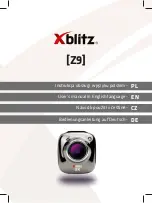
Video
VideoLapse
Slow Rec
Still
PhotoLapse Burst Mode
Video+
photo
Car Mode
Underwater
UNDERWATER MODE OPTIONS - 2
Underwater
2
All graphics, words, and layout by Troy Ferrer 2016 [email protected]
VIDEO FILE FORMAT › Choose between .MOV or .MP4.
If you are unsure which to use, choose MP4, as it is more commonly used.
BITRATE › Changes how much information is included in each frame of video.
Higher bitrates give more definition to your video at the expense of filesize.
DOUBLE FILE › When turned on, 2 copies of your current recording will be saved.
One in the current configured resolution and another in a much lower resolution.
SHARPNESS › Changing the sharpness setting will make your images either crisper
or smoother, adjust according to your preference.
WHITE BALANCE › Adjusts the color temperature of the snapshot/recording to
compensate for ambient lighting.
COLOR › You are given 5 preset choices: Normal, B&W (Black and White),
Retro (aka: “Sepia tone”), Warm (slight reddish hue), and Cool (slight bluish hue).
EV › Exposure Value - Changing EV compensates for the amount of light that is allowed in.
You can change this value to a lower setting if the scene is too bright, to compensate.
Or higher, if it is too dark, but still depends on your desired effect.
A higher EV will take longer for a photo to be taken, and will add blur to videos as each
frame takes longer to expose.
METERING › Prioritizes the brightness level of specific parts of the scene
depending on the Metering Mode that is used: Average, Center Weighted, or Spot.
DISTORTION CORRECTION › Since the lens of your action camera has a very wide FOV
(Field of View), your camera will try to fit everything in, and will result in the center
appearing to be distorted or bulging. When on, this feature will straighten the image.
Resolution
Loop Recording
FOV
Low Light Mode
WDR
Gyro Sensor
Audio
Volume
Time Stamp
Video File Format
Bitrate
Double File
Power On Record
Sharpness
White Balance
Color
EV
Metering
Distortion Correction






































